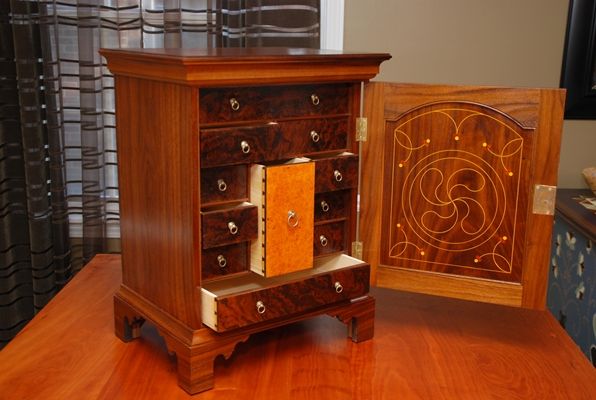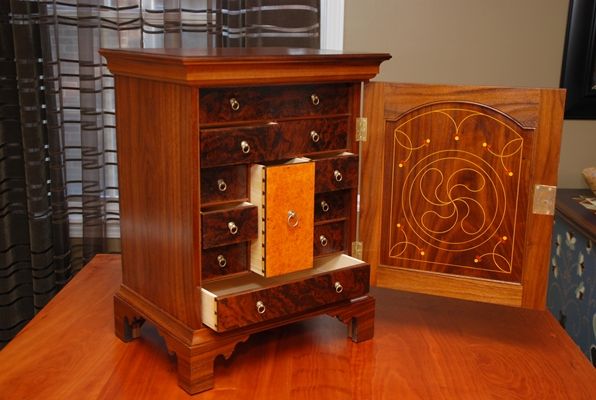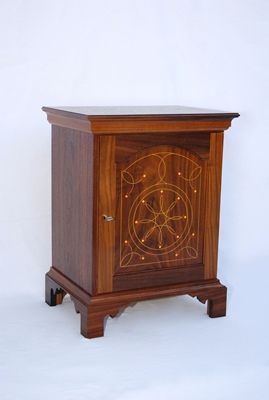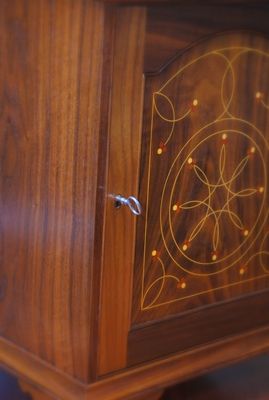Latta Pennsylvania Spice Box

I have long admired these small decorative chests, and have also wanted to learn more about hand inlay techniques. This design offered both in one project. Beyond the inlay, I found the joinery and veneering challenging and enjoyed the process of developing some new skills while working on the piece. Lots of practice on those hand dovetails too.
The case is walnut with an ash back. Poplar for the secondary wood. The drawer fronts are veneered fromone sheet of walnut burl with maple burl for the center drawer. The inlay is holly and aromatic cedar.
I would like to acknowledge and thank Mr. Steve Latta for the Inlay design and construction details.
Jim Scarsella




















Comments
Jim, outstnding work!! I am in the process of building this spice box from Steve's plans, I have the case built and have practiced some inlay as well, I purchased the inlay tools from L-N, but still have a way to go. Where did you purchase the hardware? I have been working on my chest in between other projects, and have been using this as a skill builder and probably using more hand tools such as a 71 1/2 router plane for the dados inside, etc. Anyway, you did "real good" Thanks for sharing.
Rick
firstlightwoodworking.blogspot.com
Nice work. I prefer the feet that were used on the original 1760 spice box featured in the Jan-Feb 1994 issue of American Woodworker. I studied those plans a long time and when Steve's plans were featured in FW#196 Feb 2008. I decided it was time to get started. Only problem was I did not have room for one full size. Sooo-- I divided every measurement by 2 and created one half size. Started it 8-27-09 and finished it 9-16-09. I too had problems with hardware. The best I could do was to turn the knobs out of scrap corean left over from the sink and stove top cut-outs from my kitchen remodling. The lock had to be modified and I am still fiddling with it.
Good Luck and enjoy the task, I did!
Bruce
Thanks Rick.
I used the LN inlay tools too, and fould the learning curve very quick. I purchased the hardware as listed in Steve's plans. It was not cheap for the whole package, over $300 as I recall. It is all hand forged though and gives the piece a real period feel.
Good luck on yours. I'm sure it will be beautiful.
Jim
Very nice work Jim. What wood did you use for the reddish berries? Is the inlay holly? Do you make your own inlay?
I have made two of these so far, but would like bounce some ideas re. the inlay and veneer.
Do you mind if I correspond via email with some other questions?
--Bill
[email protected]
This is absolutely beautiful!!! The detail on the front of the piece is amazing, Great Job!!
Thanks Bill,
I did use holly for the white berries and stringing and did make it from solid stock using the LN tools. The ber berries are made with aromatic cedar, whitch is traditional. They do fade considerably so I considered using something that had a brighter red tone but decided to stay true to the period.
Happy to answer any other questions you have.
Jim
[email protected]
Beautiful work. I especially like the alternating inlays on the door. Please let us know what woods and types of veneers you used.
Thanks Magnolia56.
I added the woods i used in my text by the photos.
Jim
Great work, Jim!
I'm just now starting to build this Spice Box, and am laying out dovetails. The Latta drawings have me a little confused: on Page 1 of 3, looking at the 1/2" scale layout for the Case Bottom, there are two different measurements given for the distance between the tail and the 13/16" set-back from the front of the cabinet. One is 3/16"; the other is 3/32". Is this just a misprint? Or am I not understanding something?
Thanks!
Log in or create an account to post a comment.
Sign up Log in